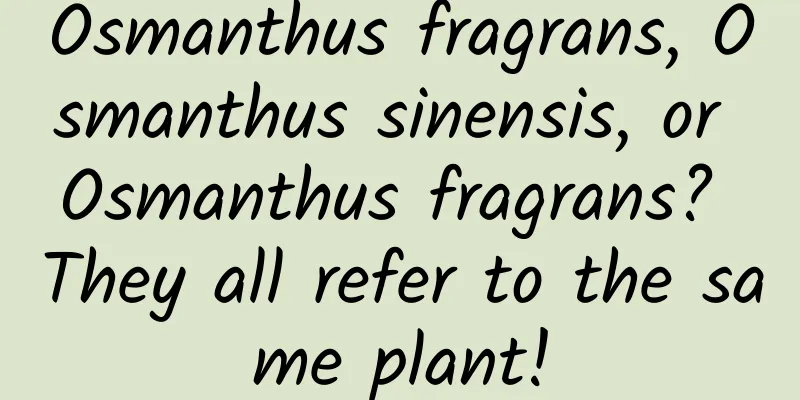Osmanthus fragrans, Osmanthus sinensis, or Osmanthus fragrans? They all refer to the same plant!

|
"The plump ears of rice bring happiness to this season, and your cheeks are like ripe tomatoes in the field. You suddenly said to me that the name of Seven-Li Osmanthus is very beautiful. But at this moment I just want to kiss your stubborn mouth..." Back then, Jay Chou's "Seven-Li Osmanthus" was popular all over the country, and the song was played in every street and alley. Does this scene look familiar to you? If not, go review it | MV "Seven Miles of Fragrance" Every bald 80s and 90s generation will occasionally hear the line "The rain fell all night, and my love overflowed like rain." The sparrows and butterflies outside the window may all outline the vague shadow of first love, but few people will delve into the question: "What is Seven-Li Fragrant Osmanthus?" The "Qilixiang" here is actually a plant, which often refers to different plants in different Chinese contexts. In the "Flora of China", there are four plants recorded as "Qilixiang", namely, white-backed maple, angustifolia, thyme and wood fragrance flower. Considering that the song was created in Taiwan, the "Qilixiang" referred to in the song should be thyme, which is the "Guixiang" we are going to introduce today. From top left: Buddleja asiatica, Elaeagnus angustifolia, Murraya paniculata and Rosa banksiae | B.navez & Franz Xaver & Dave Powell & Cillas / wikimedia A thousand miles is nine miles Murraya paniculata is a plant of the genus Murraya in the Rutaceae family. The genus name "Murraya" comes from the word "Murray" to commemorate the Swedish botanist John Andrew Murray. It is also translated as "moon orange" (not blueberry); and the specific epithet "paniculata" refers to "panicule". As an evergreen small tree, Murraya paniculata has white flowers and fragrance, and its fruits are orange-yellow to scarlet when ripe. Murraya paniculata grows in a few tropical and subtropical areas in southern my country, in low hills or high-altitude mountain forests, as well as in shrubs on flat land, gentle slopes, and hills in coastal areas. Murraya flowers | Michael Wolf / wikimedia In the past, taxonomists believed that Murraya paniculata and Murraya exotica were two species that looked similar but different. With the development of science and technology, taxonomists felt that there was no essential difference between the two. Therefore, according to the plant nomenclature rules, Murraya exotica was used as a synonym of Murraya paniculata. Correspondingly, "Jiurixiang" also replaced "Qianlixiang" as the official Chinese name of the species Murraya paniculata. Therefore, whether it is Qilixiang, Jiulixiang or Qianlixiang, they all refer to the same plant. In 1959, Huang Chengji revised the classification of Chinese Rutaceae plants, believing that Murraya paniculata corresponds to Murraya paniculata (L.) Jack, and proposed the Chinese name of its variant Murraya paniculata var. exotica (L.) CC Huang as Xiaoye Jiulixiang. In 1978, Huang Chengji again classified the Rutaceae, restoring Murraya paniculata var. exotica (L.) CC Huang to Murraya exotica L., and changing its Chinese name to Jiulixiang, while changing the Chinese name of Murraya paniculata (L.) Jack to Qianlixiang. During this period, different floras treated the two differently. Since the basal synonym of Murraya paniculata, Chalcas paniculata L., was published first, most floras believed that Murraya exotica should be a synonym of Murraya paniculata. It was not until 2016 that Mabberley conducted a type study and believed that Murraya exotica L. should be used as the proper name, and Murraya paniculata (L.) Jack should be used as its synonym. According to the principle of naming priority, the plant we are talking about today should actually be Murraya exotica L. Why is it only Xiangjiuli? But why is Jiulixiang called "Jiulixiang" instead of "Yilixiang", "Twelve Lixiang" or "Twenty-five Lixiang"? Calling it one, two or three Lixiang does not seem to be enough to exaggerate its fragrance, and the number "nine" is often used to mean "very" or "extremely", such as "beyond the nine heavens" means a very high sky, and "under the nine netherworlds" means a very deep underground or deep sea. Therefore, the term "Jiulixiang" is often used to describe plants with strong fragrance. For example, Fan Chengda once described the fragrance of osmanthus in his "Ciyun Ma Shaoyi Muxi" like this: "Slender green wrapped in golden millet, where can Jiulixiang be contained"; Fang Yue also used "Jiulixiang" in his poem "Tiantou" to describe the rich fragrance of flowers: "The rice fields are mostly white in August, and the grass and trees are just blooming with Jiulixiang." The fragrant osmanthus is also described as "Nine-mile Fragrance" | Shizhao / wikimedia There are many plants named "Xlixiang", and they generally have strong floral fragrance. Although their fragrance cannot easily drift to a few miles away, with the help of wind, it can indeed be "fragrant for ten miles". Smart working people may think: this plant is so fragrant when it blooms that it can be smelled from X miles away, so let's call it "Xlixiang". For example, Wulixiang often refers to valerian or broad-bracted chrysanthemum; Shilixiang refers to Jiulixiang; Qianlixiang refers to Jiulixiang, Daphne or thyme; Wanlixiang refers to Jiulixiang or short-calyx Pittosporum. In other words, Qilixiang, Shilixiang, Qianlixiang, Wanlixiang, and Yueju all refer to the species Jiulixiang in many cases. Valeriana officinalis and Pluchea indica | AnRo0002 / wikimedia; tropical.theferns Thousand miles of Daphne odora. | Miya / wikimedia Pittosporum brevicalyx | Daderot / wikimedia Thyme is different from other "X-lixiang". It is named not because of the flower fragrance, but the leaf fragrance. Thyme is a plant of the genus Thymus in the Lamiaceae family. When the leaves are crushed, they will emit a strong smell. Locals often use thyme leaves as seasoning to stew meat, etc., and the fragrance is unique. Coincidentally, Osmanthus fragrans can also be used as a seasoning. Osmanthus fragrans has a common name called "stone pepper", which means that it grows mostly on rocks and has a spicy taste. Thymus mongolicus | Gardening embellishment, high-priced bonsai Evergreen plants with strong floral fragrance are naturally not ignored by gardeners. In southern my country, it is often used as a fence or flowerbed, and sometimes it is used as a bonsai. Nowadays, people also use Murraya osmanthus for landscaping, potted plants, hedges, etc. When the flowers bloom, the whole city is filled with fragrance. Murraya osmanthus used as a hedge | Forest and Kim Starr / flickr As an evergreen plant in the south, Osmanthus fragrans can only grow in the south and it is difficult to survive the winter in the north. The six months from the Qingming Festival to the Mid-Autumn Festival are the flowering period of Osmanthus fragrans (sometimes it blooms in autumn and winter), giving people ample time to feel its refreshing fragrance. In the fruiting period, the red fruits of Osmanthus fragrans are matched with green leaves, which are also very gorgeous and can give people a visual impact. This plant that combines foliage, flowers and fruits in one is naturally very useful in gardening. Fruit of Murraya paniculata | Forest and Kim Starr / flickr When talking about bonsai, we naturally have to talk about bonsai speculation. Playing with bonsai is like playing with strange stones, with a high artistic conception component. Osmanthus fragrans is a frequent visitor in bonsai and is often sold at high prices. For example, at the bonsai exhibition in 2016, a mysterious person once offered 100 million yuan to try to buy a Osmanthus fragrans bonsai work. However, in the end, it was rejected by the bonsai owner, who reportedly estimated the price to be 168 million yuan. How can mortals like us understand this behavior of using a high price that can buy a courtyard house in Beijing to buy a bonsai. Osmanthus fragrans bonsai (not the most expensive one) | manuel mv / flickr Not the most expensive one | Megan Hansen / flickr The name of Osmanthus fragrans is beautiful, the flowers of Osmanthus fragrans are very fragrant, but the bonsai of Osmanthus fragrans is really too expensive. Author: Jian Yiling This article comes from the Species Calendar, welcome to forward If you need to reprint, please contact [email protected] |
Recommend
No KOC, no community
KOC , or key opinion consumer, generally refers t...
This is the essence of "brainwashing" on advertising landing pages
The advertising landing page carries an extremely...
The number of new confirmed cases in Hubei has dropped to single digits for the first time!
8 cases! #The number of newly confirmed cases in ...
Shenzhen WeChat Mini Program merchant entry process, how to activate the mini program?
When developing an e-commerce mini program , more...
The first time a northern kid saw a flying cockroach, he cried for more than half an hour!!!
Audit expert: Li Weiyang Well-known science write...
GAC Aion: From January to December 2022, Aion's cumulative sales volume reached 271,000 units, a year-on-year increase of 126%.
GAC Aion announced that it delivered 10,206 new c...
Zebra AI: APP competitive product analysis!
2020 was an extraordinary year. The arrival of th...
Genetically modified organisms have always existed in nature, such as cross-pollination of plants.
The word "genetically modified" is ofte...
Internet product monetization: transaction model and billing method of online advertising
This article will help you build the system outli...
Which WeChat mini program development company is best in Changsha? Which company is better at developing WeChat mini-programs?
Which WeChat mini program development company is ...
After taking over the channel for 5 months, I figured out all the free promotion routines in the Android market...
The matter began with a platform turnover statist...
PPT animation production tutorial including animation plug-in materials
PPT animation production tutorial including anima...
What should you pay attention to during the Spring Festival? These special groups are recommended to do this
The Spring Festival is the peak season for kidney...
The Transformation of the Shenzhou Orbital Module
The Shenzhou spacecraft is the only manned spacec...
The outstanding appearance of corals is largely due to these “green pearls”!
Zooxanthellae are yellow-brown single-celled alga...









